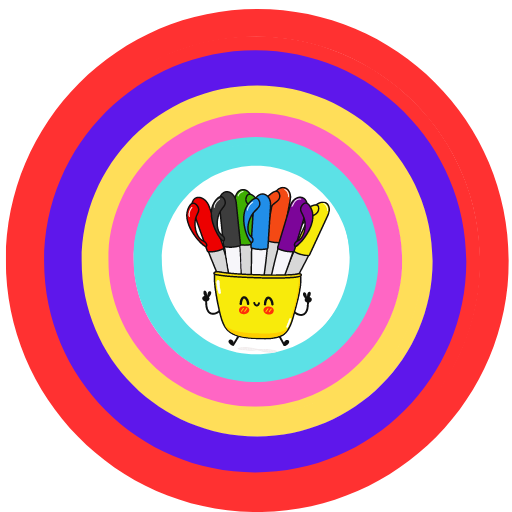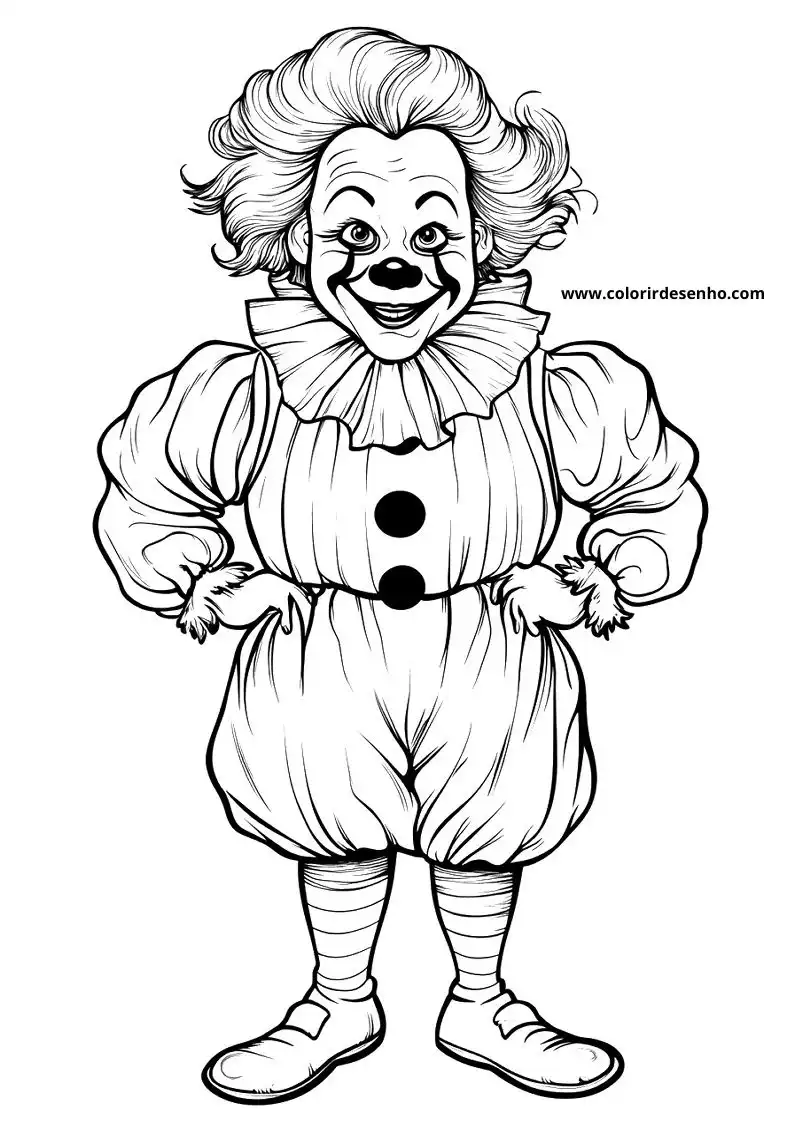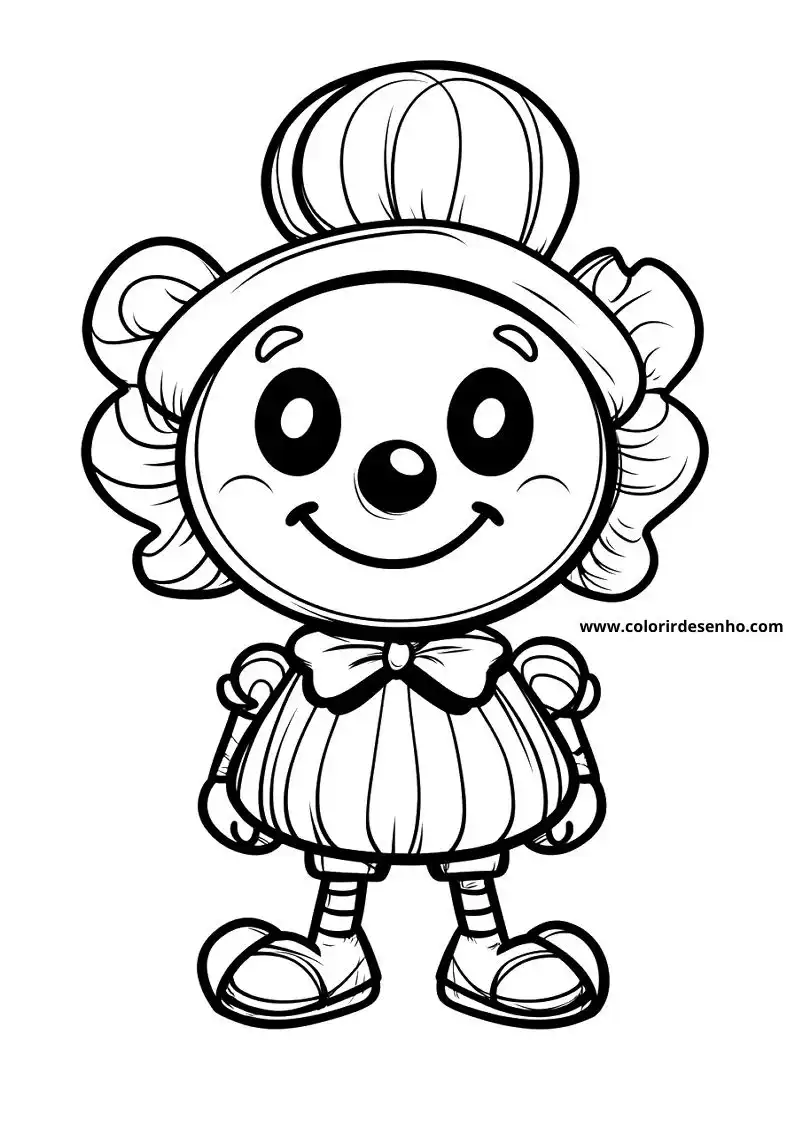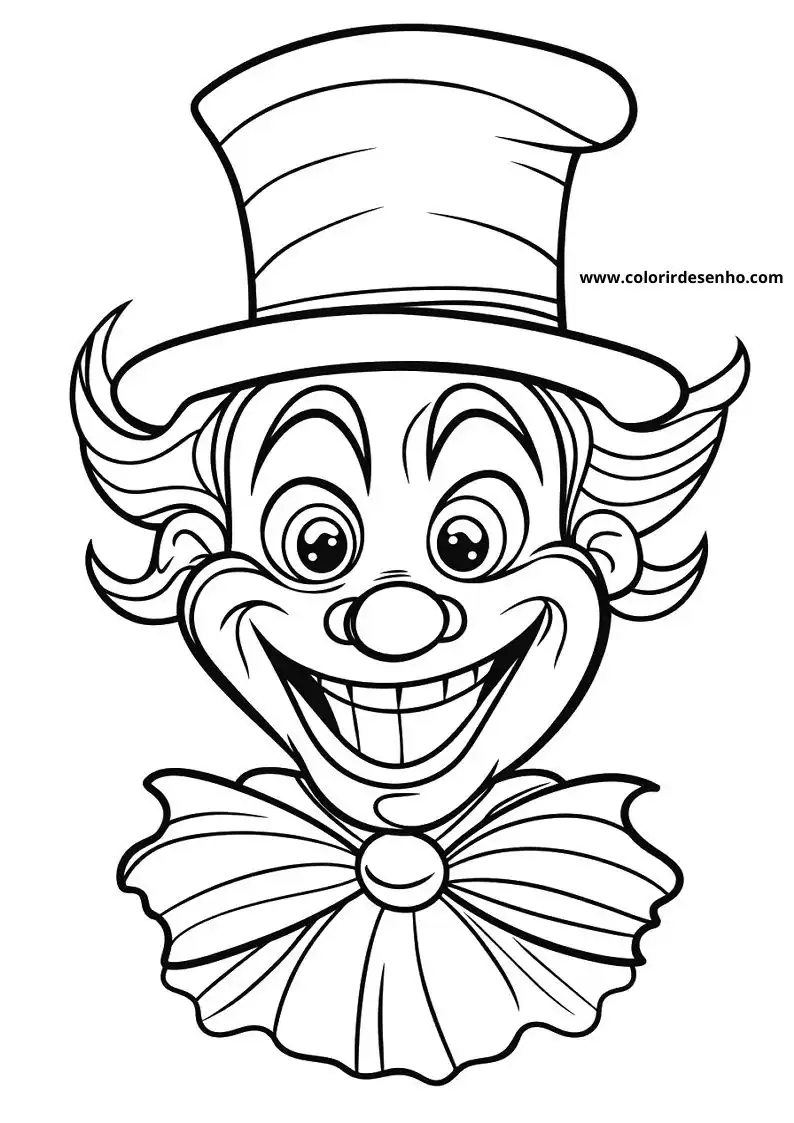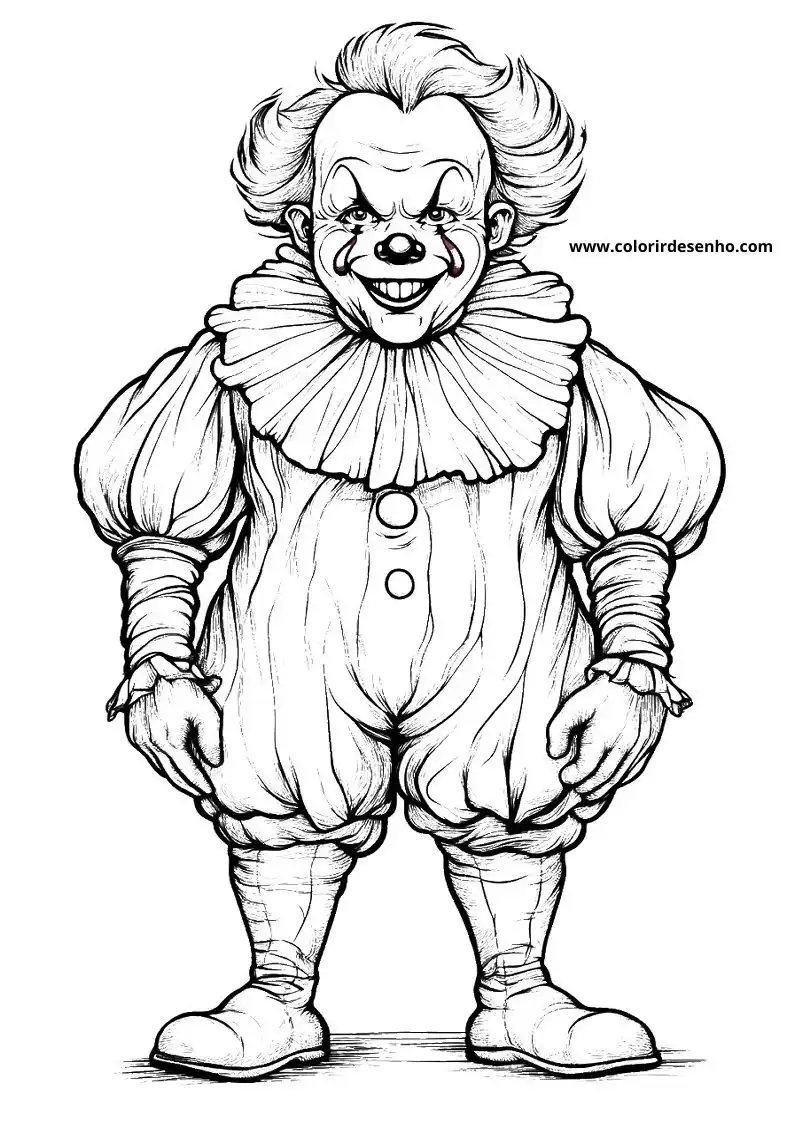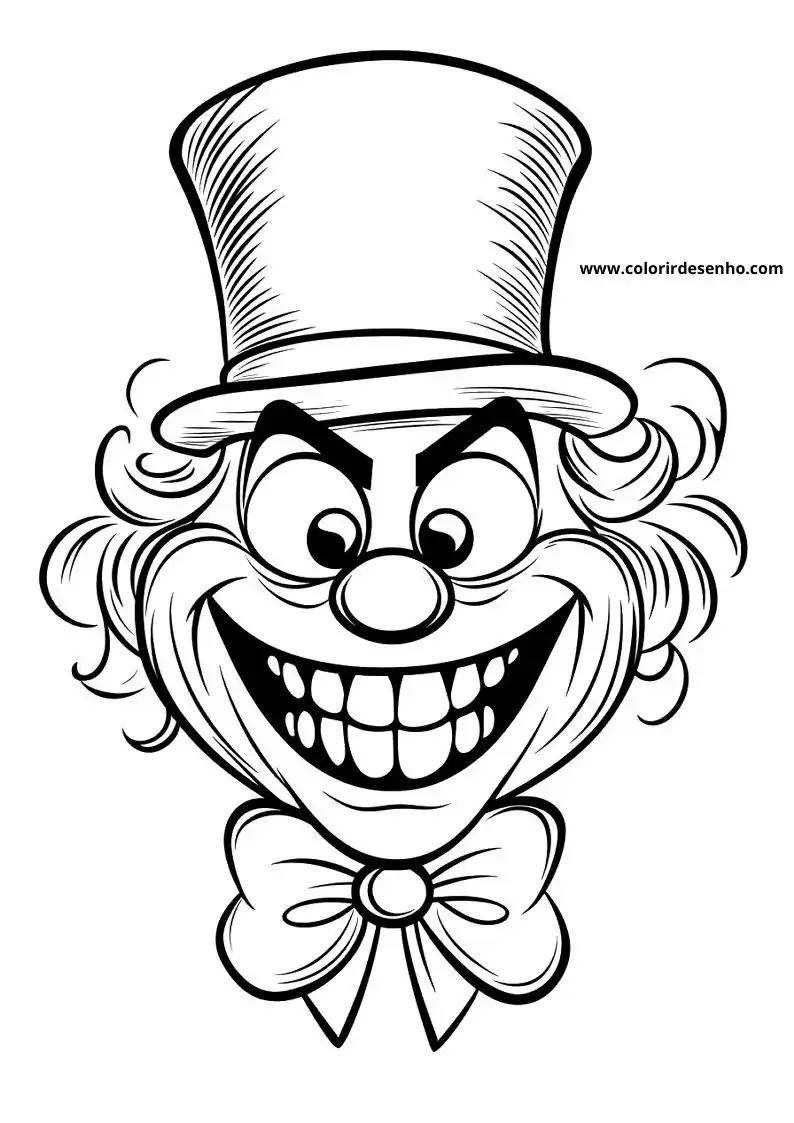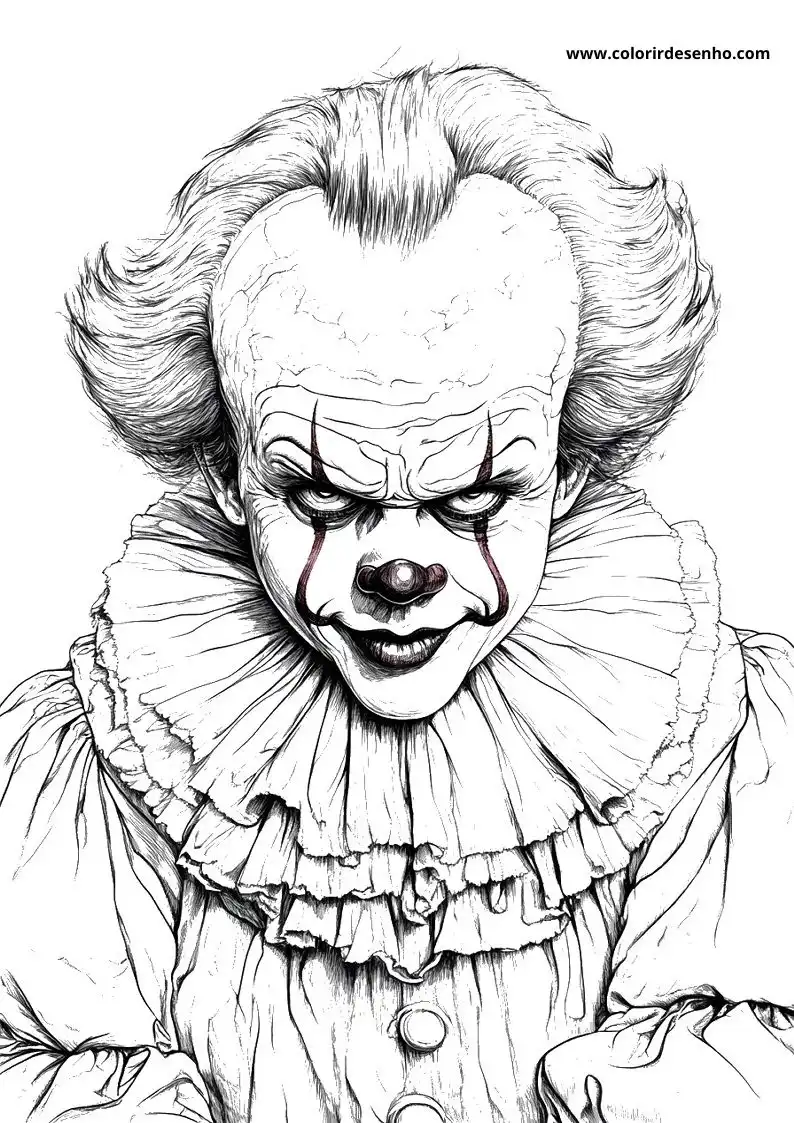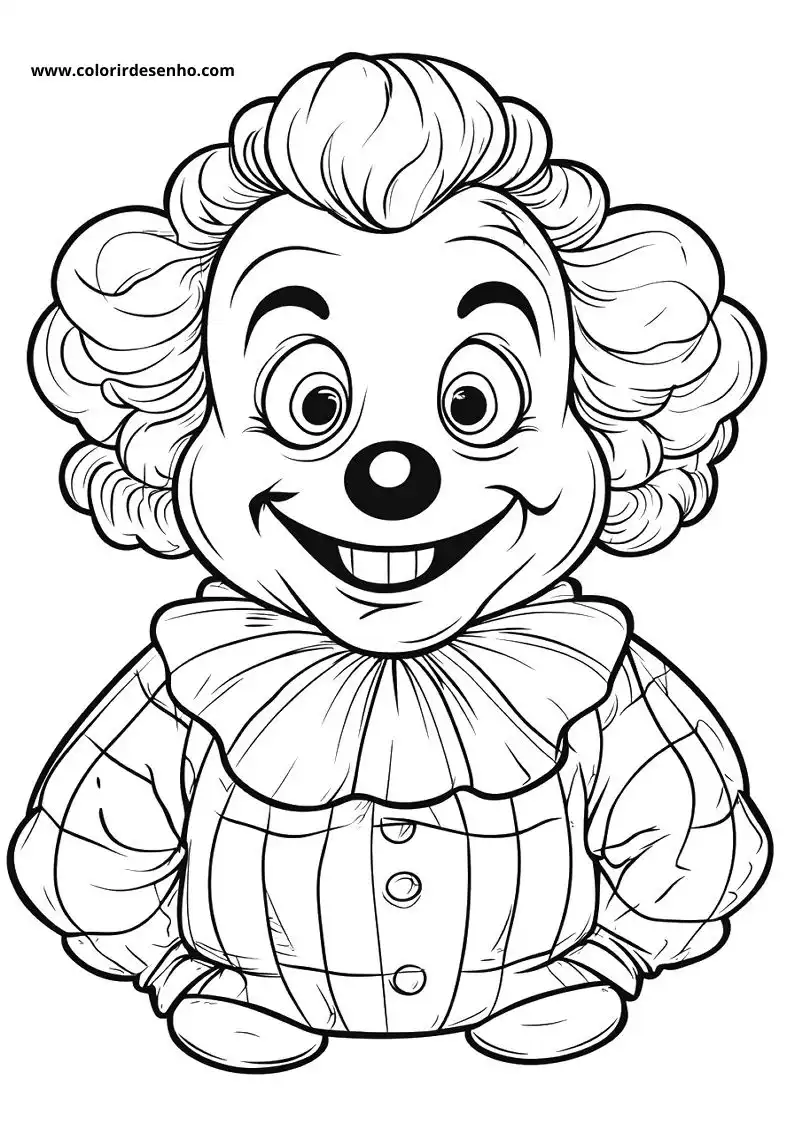Clown Coloring Pages - 224 Coloring Sheets to Print
Clown Coloring Pages are a great option if you are looking for something fun to do or a way to keep kids entertained. These images are perfect for anyone who loves to express creativity and bring life to those funny and colorful characters that have made people laugh for generations. In this article, you will find 224 realistic clown illustrations that you can download and print right at home.
Clowns have always been symbols of joy and entertainment, especially in circuses and parties. Their exaggerated expressions, colorful outfits, and amusing gestures make them fascinating figures to color. Let’s explore more about these comical characters and how you can use these incredible drawings.
Printable Clown Coloring Pages: Unique Ideas to Spark Your Creativity
Clown Coloring Pages are suitable for both adults and children. From simple sketches to more detailed illustrations, these clowns represent a wide range of emotions, from happiness to sadness. Each design offers an opportunity to explore vibrant colors and bring these funny figures to life.
Clowns are not just symbols of fun, they also carry a deep cultural significance. The image of the clown dates back thousands of years and has evolved over time to become a popular entertainment icon. Whether at the circus or birthday parties, clowns have always played an important role in delighting the audience.

THE COLORING PICTURES ARE AT THE BOTTOM OF THE PAGE, WHEN YOU OPEN THE PICTURE, CLICK ON THE SAVE BUTTON ABOVE THE PICTURE.
Clowns and Their Evolution Over Time
The clown figure has a long and interesting history. Early records of “clowns” come from ancient civilizations, where people dressed in colorful attire and acting silly took part in ceremonies and festivals. Over the years, the clown’s image was refined, taking on the shapes we know today, especially at the height of traveling circuses in Europe.
During the Middle Ages, court jesters already incorporated elements of physical comedy that would later influence the modern clown. From the 19th century onward, as circuses grew, the clown became a globally recognized figure and a symbol of universal comedy.
The Importance of the Red Nose
When we think of a clown, what stands out the most? The red nose, of course! It is the ultimate symbol of humor and fun. Although the red nose was popularized in the 19th century by circus clowns, the concept of exaggerating physical traits to create humor is much older.
The red nose was created to attract attention from a distance, essential in large circuses. It also emphasizes the clown’s facial expressions, making their reactions even funnier to the audience. Have you ever thought about how to color one of those bright noses in your Printable Clown Coloring Pages?
Curious Facts About Clowns
The world of clown drawings opens up endless creative possibilities. There are several types of clowns, each with unique traits that directly influence how you might color and interpret these characters. Among the most famous are the Auguste Clown and the White Clown, each with its own personality and style.
The Auguste Clown, for example, is the typical bumbling clown. He is the one who falls, trips, and gets tangled up, causing the biggest laughs. The White Clown, on the other hand, is more elegant and sophisticated, often acting as the troupe’s leader, creating a comic contrast with the Auguste.
The Auguste Clown
The Auguste Clown is one of the most traditional and well-known. He usually appears wearing colorful, oversized clothes, giant shoes, and somewhat messy makeup. His main function is to provoke laughter through mishaps and confusion, making him the clumsiest clown of the troupe. He is the classic character who slips on a banana peel and makes the crowd roar with laughter.
But behind all the slapstick, the Auguste also symbolizes resilience, as even with all the errors and messes, he always gets up and continues his act. When coloring an Auguste Clown, you can use strong, vibrant tones, reflecting his energetic personality.
The White Clown
In contrast, the White Clown is the opposite of the Auguste. He is serious, disciplined, and almost always the leader of the group. His attire is more refined, and his makeup is clean, often using white and gold, conveying an elegant feel. He is responsible for guiding the acts and organizing the chaos the Auguste creates.
When coloring a White Clown, you can explore a more sober color palette, with touches of luxury like gold, silver, or black. His sophisticated personality makes him a fascinating figure to work with in terms of shading and details.
How the Clown Became a Cultural Symbol
Clowns are not only circus characters. They have also become cultural symbols, appearing in movies, parties, and even in therapies. The clown figure has crossed cultural borders and taken on different forms around the world. A classic example is Pierrot, the sad clown of Italian comedy, who has inspired countless artists over the centuries.
Pierrot, for instance, is a melancholic and romantic figure, usually depicted in softer, sadder colors. He represents the more introspective and poetic side of the clown, in contrast to the happier and funnier circus clowns.
Pierrot: A Story of Love and Sadness
Pierrot is a classic figure from the Commedia dell’Arte, an Italian theatrical style from the 16th century. Unlike traditional clowns, Pierrot is known for his melancholic and passionate behavior. He is always in love with Columbine, who never returns his affection, creating an aura of sadness around him.
If you choose a Pierrot drawing to color, you might explore softer and cooler tones like white, gray, and light blue to reflect his sorrowful personality. He offers a great opportunity to work with more subtle and delicate shading.
The Impact of Clowns on Pop Culture
Clowns have also found their place in pop culture, and not only as funny figures. Characters like the Joker from Batman show how the clown’s image can be used in unexpected and even disturbing ways. The contrast between the joy of a traditional clown and the Joker’s dark persona fascinates audiences and reinforces the clown’s symbolic power.
Over the years, various films, series, and comics have explored this duality of the clown, capable of bringing both laughter and a slight feeling of unease. These characters prove that clowns are versatile and can represent both joy and chaos.
Different Clown Styles to Color
Within the universe of coloring activities, you will find clowns depicted in a wide range of styles. From classic circus clowns with their colorful outfits and exaggerated expressions to more minimalist and modern clowns. Each style offers a unique opportunity to explore colors, shapes, and strokes.
Circus clowns are probably the best known. They usually wear outfits with stripes, polka dots, and other patterns that offer plenty of creative options when coloring. Modern clowns, with fewer details, present a cleaner style, perfect for those who prefer working with a reduced color palette.
Circus Clowns
Circus clowns are the most iconic. They wear large, eye-catching clothes, with lots of vibrant colors and accessories such as giant ties, colorful wigs, and enormous shoes. These designs are perfect for those who love to unleash their imagination and play with multiple colors.
Besides being fun to color, these clowns offer many opportunities to explore patterns like stripes, dots, and geometric shapes. Each part of a circus clown’s costume can become a burst of colors.
Modern and Minimalist Clowns
On the other hand, if you prefer something more discreet, modern clowns offer a different approach. They usually have simpler, more elegant outfits, and their expressions are more subtle. The focus here is on simplicity and minimalism, allowing you to work with a limited color palette.
These minimalist clowns still maintain the comic and fun spirit of traditional clowns, but with a contemporary twist. They are perfect for those who enjoy exploring a modern and clean aesthetic.
Clowns at Children’s Parties
It is hard to think of a child’s party without picturing a clown entertaining the kids. In addition to being funny figures, clowns bring contagious energy by performing tricks, telling jokes, and playing games. Many party clowns also do face painting, balloon sculptures, and even magic tricks, ensuring everyone has a great time.
At birthday parties, it is common to see clowns wearing bright, colorful outfits, making them perfect themes for decoration. You can take advantage of Clown Coloring Sheets to Print and create a fun activity for the children during the party. They can color their own clowns while enjoying themselves.
The Art of Making Everyone Laugh
The ability to make people laugh is one of a clown’s greatest qualities. Whether through silly jokes, funny falls, or exaggerated faces, they have a unique way of winning the audience over. This physical comedy, also known as slapstick, is one of the oldest forms of humor and continues to be successful in parties and shows today.
The secret lies in exaggerating actions, turning something simple like tripping or falling into something extremely amusing. This makes the audience relate and laugh at the absurdity. When choosing a clown to color, you can emphasize these comic traits with bright colors and exaggerated lines, highlighting his funny side.
Fear of Clowns: Coulrophobia
Despite all the humor and joy clowns bring, some people are afraid of them, a condition known as coulrophobia. This fear can be triggered by their exaggerated expressions, makeup, or even their strange behavior. For some, the idea of a clown, with its permanent smile and penetrating gaze, is more frightening than funny.
This phobia has been explored in various media, especially horror films, where clowns are used to provoke fear. However, for many, clowns remain friendly and entertaining figures, perfect for coloring and having fun.
Using Clown Drawings for Educational Activities
Clown Coloring Sheets are also great educational resources. Coloring is an activity that helps develop motor skills, color perception, and coordination in children. In addition, clowns can be used to teach about emotions, colors, and even the history of the circus.
For instance, when coloring a clown, kids can learn the difference between warm and cool colors, mixing and matching tones to create new palettes. This activity can also be used to explore themes like happiness, sadness, and other emotions reflected in the clown’s facial expressions.
The Importance of Clowns in Therapy
Another interesting fact about clowns is their use in therapy, especially in hospitals. “Doctor clowns” use humor to relieve tension and bring comfort to patients, mainly children. With their jokes and funny behavior, they help transform the hospital environment, making it lighter and more welcoming.
This therapeutic work, known as “laughter therapy,” has shown positive results in patient recovery by reducing stress and promoting a sense of well-being. Therefore, the clown, beyond being a character for parties and circuses, plays an important role in people’s emotional health.
Famous Clowns in Brazil
In Brazil, clowns are an integral part of the entertainment culture, especially on television shows and popular celebrations. One of the country’s most iconic clowns was Bozo, who became immensely popular in the 1980s and 1990s. With his irreverent and funny style, he marked the childhood of many generations.
Another famous example is the duo Patati Patatá, who still captivate children with their cheerful music and performances. They are known for their colorful outfits and always smiling faces, making them perfect subjects for you to depict in your Printable Clown Pictures to Color.
Finishing Your Artwork
Now that you know more about the history, different styles, and importance of clowns, it’s time to pick your Free Printable Clown Coloring Pages and start unleashing your creativity! Whether you choose a happy circus clown, a sophisticated White Clown, or even a melancholic Pierrot, each illustration provides a unique opportunity to explore your imagination.
Use your favorite colors, have fun with the details, and don’t forget to experiment with different combinations and techniques, creating an artwork that reflects your own interpretation of this classic and timeless character. In the end, Clown Coloring Pages will help you enjoy every step of the coloring process.
